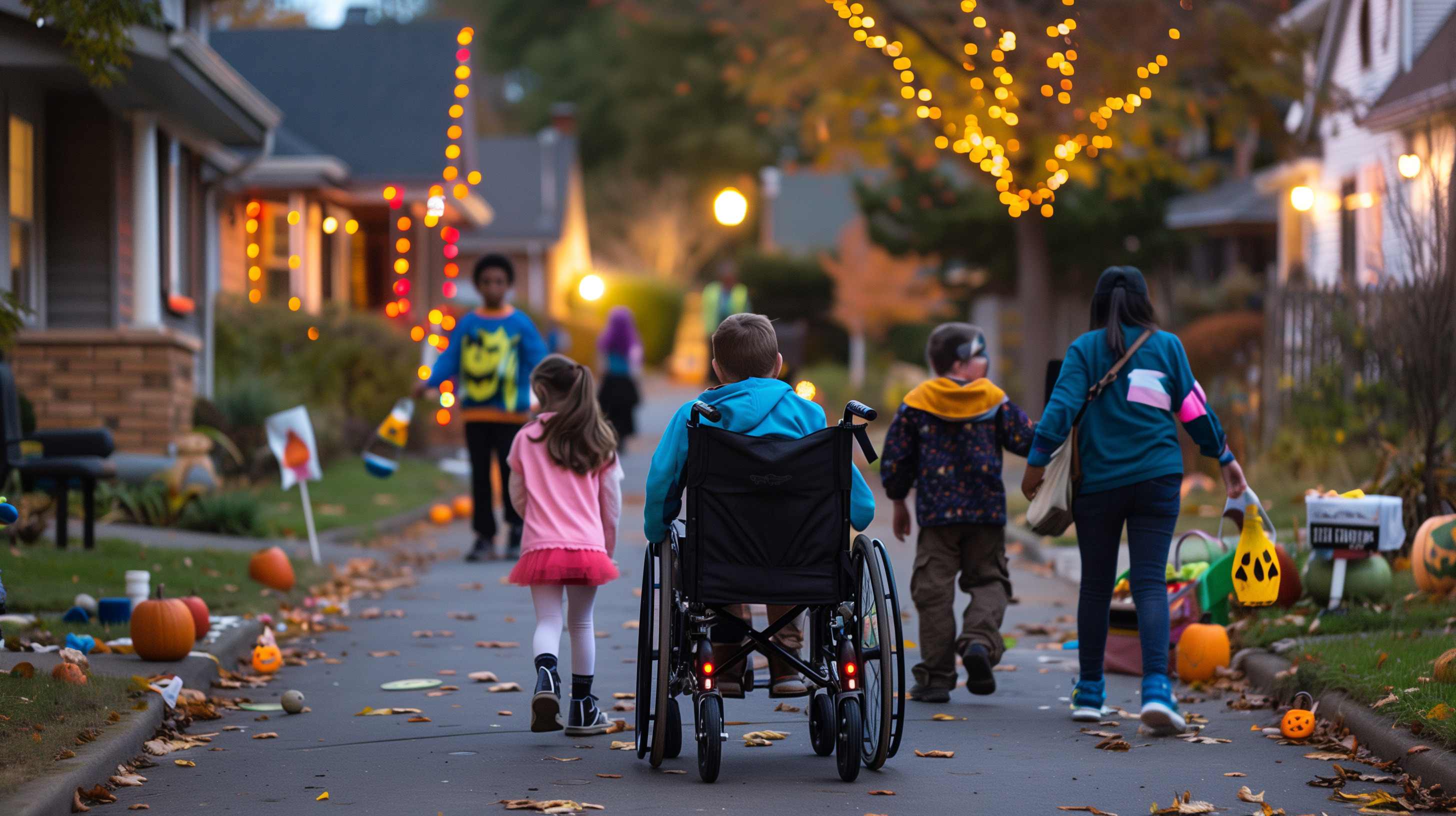Written by: Amanda Phillips
Halloween is one of the most magical times of the year when kids get to dress up, eat candy, and have fun in their neighborhoods. For children with medical conditions, however, traditional trick-or-treating can present challenges that make it hard for them to fully join in the fun. Whether due to mobility issues, dietary restrictions, or even being in the hospital, many kids with complex medical needs face barriers to enjoying Halloween like other children.
With a little creativity and compassion, we can make this festive day of fun more inclusive for all kids, regardless of their health conditions. Here are some ideas to ensure every child has a great Halloween, no matter their medical needs.
Making Trick-or-Treating Accessible for Kids in Wheelchairs
Trick-or-treating can be particularly challenging for children in wheelchairs or using other mobility aids. Crowded sidewalks, steps, or narrow doorways can present obstacles. Here’s how to help make it more accessible:
- Accessible Routes: Plan a trick-or-treat route that includes homes with ramps, wide sidewalks, and low doorbells that are easy to reach. Apps and websites can help map out accessible routes in your area.
- Trunk-or-Treat Events: “Trunk-or-treating” takes place in a parking lot, where treats are handed out from the trunks of cars. The area is flat and open, making it easier for kids with mobility aids to move between stops.
- Wheelchair-Friendly Costumes: Get creative by adapting wheelchairs into race cars, pirate ships, or fairy-tale castles. This makes costumes more stable and can be a fun, empowering experience for the child.
Accommodating Kids with Feeding Restrictions
Traditional Halloween candy isn’t an option for kids with feeding tubes or highly restricted diets, but that doesn’t mean they can’t enjoy the holiday. Here’s how to create a fun, food-free Halloween experience:
- Non-Food Treats: Hand out small toys, stickers, or other trinkets instead of candy, allowing kids with dietary restrictions to still participate in trick-or-treating.
- Teal Pumpkin Project: Participate in the Teal Pumpkin Project by offering non-food treats. Place a teal pumpkin on your front step to signal that you have allergy-friendly treats available.
- Plan Alternative Activities: For children who can’t have candy, organize a Halloween-themed scavenger hunt with small toys, stickers, and other non-food items.
Accommodating Children with Prosthetics
Children with prosthetics may have difficulty walking for long periods, and costumes can sometimes be uncomfortable. Here are some ways to make trick-or-treating more enjoyable:
- Adapt Costumes: Choose costumes that allow for easy movement and comfort, like capes, tunics, or loose-fitting outfits.
- Leave Time for Rest Breaks: Plan to take breaks while trick-or-treating. Have a stroller, wagon, or other mobility aid available in case the child becomes tired.
- Sensory-Friendly Costumes: Children with prosthetics may also have sensitivities to certain textures. Opt for simple costumes without itchy elements, using materials that feel good on their skin.
Including Kids Who Are in the Hospital
For children spending Halloween in the hospital, traditional trick-or-treating may not be an option, but there are still ways to bring the holiday spirit to them:
- Organize a Hospital Parade: Many hospitals host Halloween parades where staff or volunteers dress up and deliver treats to children in their rooms. Community groups can liaise with hospitals to bring fun to young patients.
- Virtual Trick-or-Treating Events: Family and friends can join virtually via video chat, showing off costumes and sending love. Friends can also mail small Halloween-themed gifts for children to open during the call.
Thinking Outside the Box for All Medically Complex Kids
Yes, there are barriers for kids with medical needs, but a little creativity can help make Halloween fun for all children. Here are some additional ideas:
- Host a Sensory-Friendly Event: For kids who may be overstimulated by loud noises, flashing lights, and crowded spaces, host a sensory-friendly Halloween event with soft lighting, low music, and a quiet environment.
- Indoor Trick-or-Treating: For children who have difficulty moving around or need to stay warm, set up a trick-or-treat trail indoors, using different rooms or stations throughout the home.
- Adapt Trick-or-Treating Times: Many children with chronic illnesses have more energy earlier in the day. Start trick-or-treating in the afternoon or throw an early Halloween party to accommodate kids with different energy levels.
Conclusion: Making Halloween Enjoyable for All Kids
Halloween should be a time of fun, laughter, and excitement for all children, including those with medical conditions. With a few adjustments and some creative thinking, we can ensure that every child can participate in the festivities safely and enjoyably.
Whether it’s adapting costumes, offering non-food treats, or organizing a hospital parade, let’s make Halloween a holiday to remember for every child, no matter their medical needs.



Holiday Cheer When You Have Chronic Pain
Understanding Medical Gaslighting: What It Is and How to Respond